Fanless HTPC based HD-Plex chassis overview
Hello. In this post, I want to talk about my experience in assembling a fanless HTPC (in fact, a computer media player; in the absence of an absolutely silent HDD) based on the HD-Plex chassis : selection, delivery, assembly, and results. I hope my opus will be useful to someone and, perhaps, will motivate the assembly of a similar device.
Under the cut a lot of photos.
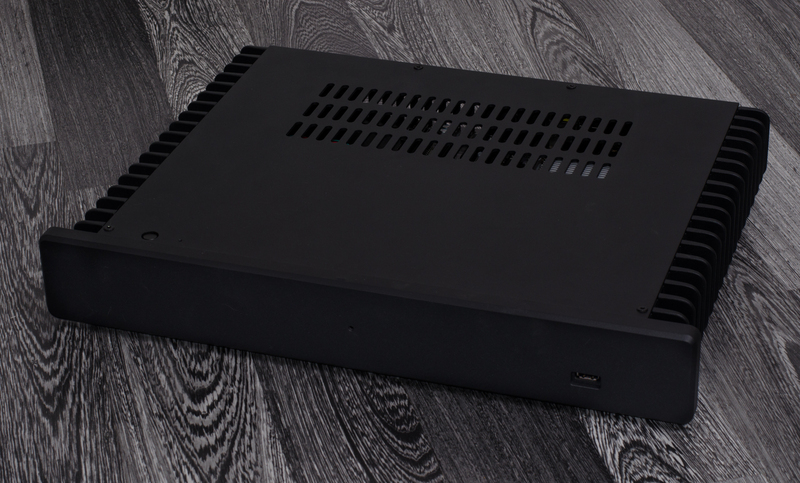
The company offers several options (3rd series for Mini ITX, 5th and 10th for Mini ITX and Micro ATX). Available with and without drive.
I liked the black H5.S chassis most of all without the possibility of installing the drive.
The process of placing an order is interesting in several things: the guys are sent to all the countries of North America, Europe, Russia and Australia. For Europe and Russia, DHL is used (more precisely, it belongs to the same group as the Deutsche Post DHL) and is shipped from Hamburg, Germany. Delivery costs $ 30 and the seller returns these same $ 30 after writing a short review with a couple of pictures.
Payment via PayPal or credit cards. After payment the order status is displayed in your account.
Later, a not very pleasant moment surfaced (I would have thought that this was an isolated case, but a similar case was ordered by a man from Latvia with me): the goods were shipped only 2 weeks after the order was paid. Perhaps I'm used to the conditions of Ebay, where the shipment occurs within 1-2 days, but the fact remains.
On March 19, the status changed and the DHL tracking number came to the post office.
On March 30, the corps was delivered to me. Thus, 11 days have passed since the moment of delivery, and 26 days since the moment of payment.
The final price looks like this:
The final price: $ 358, which in my opinion is comparable to the price of a normal case, power supply, cooling system and remote control.
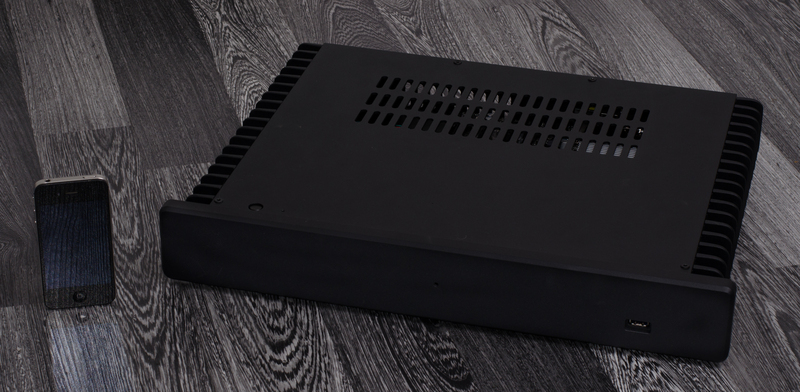
The instruction was included, although at first it looked quite complicated, the assembly process turned out to be simple. There is no sense in going deeper into this question, since the one who decides to order a case will also receive instructions.
I will dwell on a couple of interesting moments from my point of view. The case is very high quality, weighty. It looks much more than in the pictures. Included is everything that is necessary for all supported types of processors and motherboards: a passive cooling system consisting of a copper plate, tubes, a radiator, fasteners and thermal paste; various fastenings, bolts, holders.
The front plate is not hollow, made of aluminum, has a thickness of 15 mm. There is a small hole for the IR receiver, output for USB port. The power button (which can be used instead of the power from the IR remote control). The bundled IR receiver connects to a USB 2.0 port or, if the motherboard does not support switching on from USB, directly to the PSU.
Heat pipes from the copper plate on the processor go to the pipe receivers on the inner sidewalls of the case, the heat from which is transferred to an external radiator, which is located along all the ends of the case.
Result:
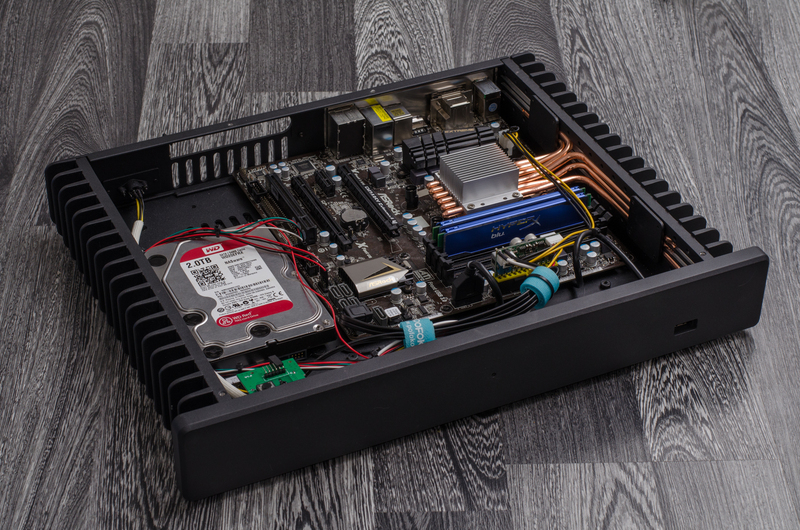
View from above:

There is one interesting point. The seller states that for motherboards based on Intel processors, all 6 heatpipes are used, and for motherboard plans on AMD processors only 4, 2 are sent for scrap. I thought that this was due to the location of the socket, but it turned out that the plastic holders for the radiator mounting bolts on the motherboard, which are cut in 10 seconds, interfere with the kit. All 6 heatpipes were hoisted into place.
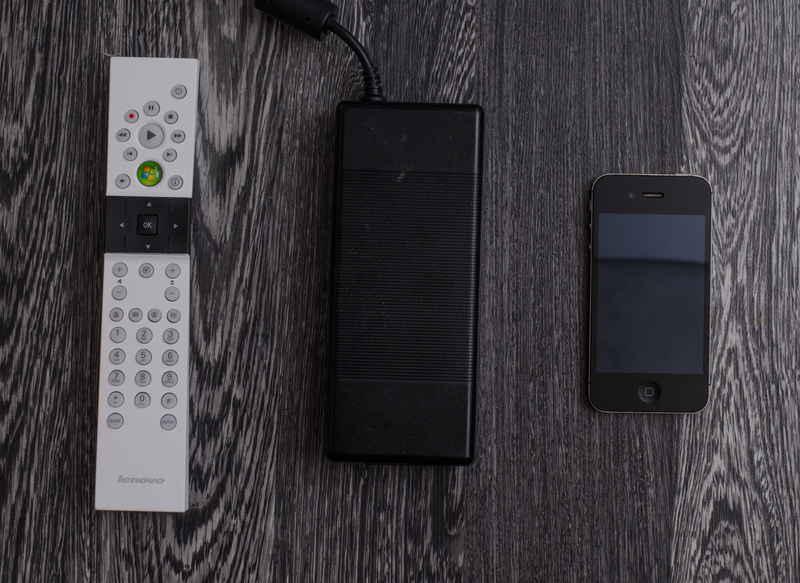
A laptop power supply unit for 180 W was ordered, no additional manipulations were carried out - everything is already screwed and screwed. The power supply is impressive in size and can be placed inside the case provided the installation of a 2.5 "HDD or SSD (For this, special mounts are included). Since I have a 3.5" HDD, the power supply had to be taken out.
The complete remote is white, of medium quality, normally lies in the hand. The stuff is much better than the complete Dune HD junior player console, but worse than the remote controller that comes with Popcorh Hour players. Without backlight. The computer, if desired, is switched on from the built-in IR receiver.
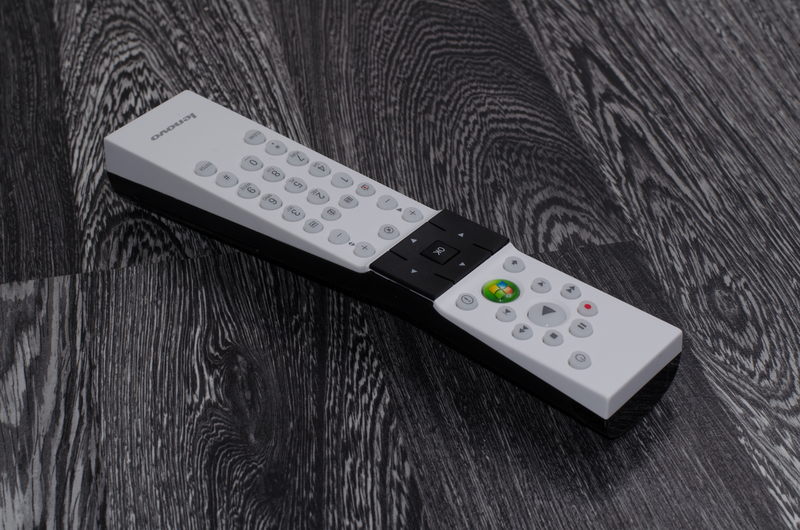
But from the point of view of performance, I did not like the bundle receiver. Whether due to the fact that the receiver is deeply drowned, or due to some other reasons, but the IR receiver receives the signal from the console strictly from one position and from an angle with small deviations — from top to bottom vertically, clearly directing the console into the receiver horizontally. And even this does not guarantee normal reception.
The IR receiver turned off, turning on / off the HTPC brought it back to the button on top, looking for a high-quality radio remote.
I do not recommend to buy a complete IR receiver with remote control. Save $ 15.
For 3D, I use TotalMedia Theater 6
In any case, the heat dissipated from the processor and other components is the same with fans and with a passive system.
I used the system monitoring tools to get information about the temperature of components and an infrared thermometer to take readings from the case and cooling elements. The HTPC worked with the lid closed, and the lid opened at the time of reading.
Under the spoilers, I will bring a photo from an infrared thermometer. The temperature on the case was measured from the hottest point: inside the radiator, fingers do not climb there. In ascending order.
2) I consider the temperature conditions normal. He does not ask to eat, the heat dissipated is the same as in the case of active and passive cooling. Enclosure suitable for use 24/7;
3) I think the price is more than acceptable - at the level of a decent case with active cooling;
4) Remote control receiver is a disappointment.
1) Why does the idle temperature differ so much with the idle media temperature (=> why the load is cast)? A difference of 20˚ C is significant. But that is not all. The temperature in Blu-Ray playback mode is lower than in media shell idle mode, which means that in idle mode, the shell itself loads the GPU (since the CPU load is within 0–3%). There is a suspicion that the Aeon Nox skin can do this, I will try to change it to the standard one);
2) Why is the BIOS so heavy on the processor at least?
3) I nakosyachil with thermopaste - poured it too much. There are plans to replace it with another one and apply it with a thin layer, as well as apply thermal grease to the pipe receivers in the housing.
Under the cut a lot of photos.

Prehistory There is nothing important, so I will put it under the spoiler
I have always been a supporter of media players because of their miniature, lack of fans, ease of operation, reliability and relative glitch-free. In total, I had: Dune HD TV-101W , Apple TV (not exactly a media player, but an extender), Pioneer BDP-140 , Popcorn Hour A-300 .
')
Special mention deserves the last media player, as it was acquired after the purchase of a new TV and the adoption of walking on the construction of a home theater.
After the modern 65 "plasma was acquired, it became clear to me that the existing players did not fit the possibilities for my tasks, but did not want to collect HTPC: the price was biting, and you could see constant tambourine dances. As a result, the Popcorn Hour A media player The manufacturer declared a convenient media library with autoloading information, posters, fanart, etc. You can ask why the choice did not fall on a more modern A-400 . The answer is simple - the creepy bugs of the latter and the presence of A-300 Blu. Ray menu. Back to our sheep. What happened in the end? XB Network Media Jukebox (written in a flash, by the way), to put it mildly, was not as beautiful and concise as it could seem from the screenshots, and it also slowed down so that the response to the command from the console reached a second. several unrecoverable glitches, the result of which was the return of the player to the store.
Then I put the XBMC on the laptop, poyuzal a bit and realized that communism had almost arrived for me and I needed to collect HTPC.
There were attempts of adherents to dissuade this venture due to possible problems with the sound output to the receiver, dances with a tambourine and other delights.
')
Special mention deserves the last media player, as it was acquired after the purchase of a new TV and the adoption of walking on the construction of a home theater.
After the modern 65 "plasma was acquired, it became clear to me that the existing players did not fit the possibilities for my tasks, but did not want to collect HTPC: the price was biting, and you could see constant tambourine dances. As a result, the Popcorn Hour A media player The manufacturer declared a convenient media library with autoloading information, posters, fanart, etc. You can ask why the choice did not fall on a more modern A-400 . The answer is simple - the creepy bugs of the latter and the presence of A-300 Blu. Ray menu. Back to our sheep. What happened in the end? XB Network Media Jukebox (written in a flash, by the way), to put it mildly, was not as beautiful and concise as it could seem from the screenshots, and it also slowed down so that the response to the command from the console reached a second. several unrecoverable glitches, the result of which was the return of the player to the store.
Then I put the XBMC on the laptop, poyuzal a bit and realized that communism had almost arrived for me and I needed to collect HTPC.
There were attempts of adherents to dissuade this venture due to possible problems with the sound output to the receiver, dances with a tambourine and other delights.
Tasks:
- Laconic appearance;
- The complete absence of fans (and subsequently, after replacing the HDD to SDD - complete noiselessness);
- Playing everything and everything. Emphasis on Blu-Ray, Blu-Ray 3D;
- Audio output (DTS, DTS HD, etc.) to the receiver;
- This should be a media player format, not a computer;
- The price must be within reasonable limits.
Body selection
For HTPC, almost the most important parameter is the case, its form factor and cooling system. Many options have been explored, but I finally understood that I want a device that is different from the usual PC and with no fans at all. Ready-made solutions for fanless HTPCs are offered by several companies, but the HD-Plex cases looked to me the most. Firstly, because of the appearance, secondly because of the complete set (body, PSU, Pico PSU, IR receiver and remote control), and thirdly, because of very good support: the guys are almost immediately responsible for supported configurations, issues of delivery, payment, etc.The company offers several options (3rd series for Mini ITX, 5th and 10th for Mini ITX and Micro ATX). Available with and without drive.
I liked the black H5.S chassis most of all without the possibility of installing the drive.
Checkout, payment, delivery
Along with the case and the passive cooling system, a laptop power supply unit 180 W, a Pico PSU DC-DC adapter, an IR receiver and a remote were ordered from the same seller.The process of placing an order is interesting in several things: the guys are sent to all the countries of North America, Europe, Russia and Australia. For Europe and Russia, DHL is used (more precisely, it belongs to the same group as the Deutsche Post DHL) and is shipped from Hamburg, Germany. Delivery costs $ 30 and the seller returns these same $ 30 after writing a short review with a couple of pictures.
Payment via PayPal or credit cards. After payment the order status is displayed in your account.
Later, a not very pleasant moment surfaced (I would have thought that this was an isolated case, but a similar case was ordered by a man from Latvia with me): the goods were shipped only 2 weeks after the order was paid. Perhaps I'm used to the conditions of Ebay, where the shipment occurs within 1-2 days, but the fact remains.
On March 19, the status changed and the DHL tracking number came to the post office.
On March 30, the corps was delivered to me. Thus, 11 days have passed since the moment of delivery, and 26 days since the moment of payment.
Box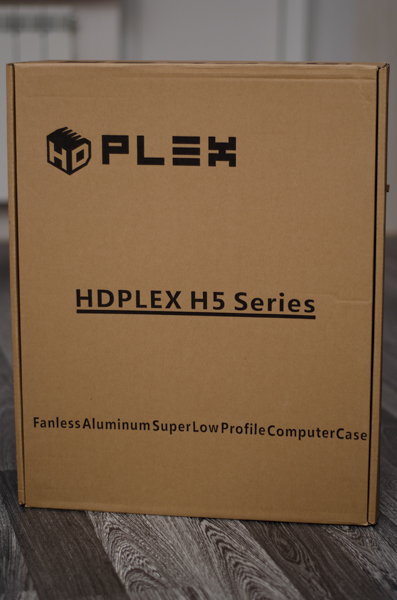

Issue price
HD-Plex offers different chassis, but they are not dramatically different. H5.S - chassis of an average price category.The final price looks like this:
- Chassis HD-Plex H5.S - $ 258;
- 180W PSU + Pico PSU - $ 85;
- IR receiver and remote - $ 15;
The final price: $ 358, which in my opinion is comparable to the price of a normal case, power supply, cooling system and remote control.
Configuration
So, based on the requirements, the following config was chosen:- Motherboard: AsRock FM2A85X EXTREME4-M (selected not only by specifications, but also by HD-Plex compatibility list);
- Processor: AMD A10-5700 (selected as the most powerful AMD processor compatible with the cooling system. Intel was not considered fundamentally due to the problems of integrated graphics with video playback with a frequency of 23.976 FPS and much less productive graphics);
- RAM: Kingston 2x2 GB DDR3-1600 (more volume for HTPC is useless);
- HDD: WD Red 2 TB (a temporary solution before purchasing SSD and NAS);
Assembly

The instruction was included, although at first it looked quite complicated, the assembly process turned out to be simple. There is no sense in going deeper into this question, since the one who decides to order a case will also receive instructions.
I will dwell on a couple of interesting moments from my point of view. The case is very high quality, weighty. It looks much more than in the pictures. Included is everything that is necessary for all supported types of processors and motherboards: a passive cooling system consisting of a copper plate, tubes, a radiator, fasteners and thermal paste; various fastenings, bolts, holders.
The front plate is not hollow, made of aluminum, has a thickness of 15 mm. There is a small hole for the IR receiver, output for USB port. The power button (which can be used instead of the power from the IR remote control). The bundled IR receiver connects to a USB 2.0 port or, if the motherboard does not support switching on from USB, directly to the PSU.
Heat pipes from the copper plate on the processor go to the pipe receivers on the inner sidewalls of the case, the heat from which is transferred to an external radiator, which is located along all the ends of the case.
Result:

View from above:

There is one interesting point. The seller states that for motherboards based on Intel processors, all 6 heatpipes are used, and for motherboard plans on AMD processors only 4, 2 are sent for scrap. I thought that this was due to the location of the socket, but it turned out that the plastic holders for the radiator mounting bolts on the motherboard, which are cut in 10 seconds, interfere with the kit. All 6 heatpipes were hoisted into place.
Remote, power supply

A laptop power supply unit for 180 W was ordered, no additional manipulations were carried out - everything is already screwed and screwed. The power supply is impressive in size and can be placed inside the case provided the installation of a 2.5 "HDD or SSD (For this, special mounts are included). Since I have a 3.5" HDD, the power supply had to be taken out.
The complete remote is white, of medium quality, normally lies in the hand. The stuff is much better than the complete Dune HD junior player console, but worse than the remote controller that comes with Popcorh Hour players. Without backlight. The computer, if desired, is switched on from the built-in IR receiver.

But from the point of view of performance, I did not like the bundle receiver. Whether due to the fact that the receiver is deeply drowned, or due to some other reasons, but the IR receiver receives the signal from the console strictly from one position and from an angle with small deviations — from top to bottom vertically, clearly directing the console into the receiver horizontally. And even this does not guarantee normal reception.
The IR receiver turned off, turning on / off the HTPC brought it back to the button on top, looking for a high-quality radio remote.
I do not recommend to buy a complete IR receiver with remote control. Save $ 15.
Little about software
I use Windows 7 X86 as a system. Media Shell - XBMC. I like it the most. They will not go into any details, as this is beyond the scope of this review, but I will provide some screenshots from the media shell.Screenshots of my XBMC

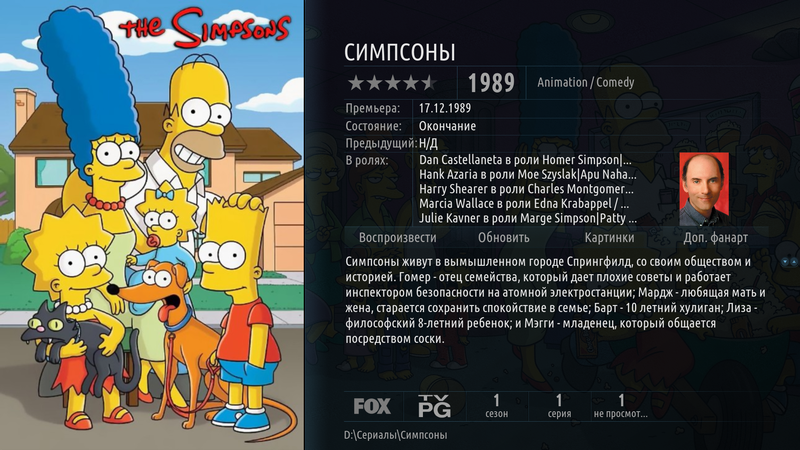





For 3D, I use TotalMedia Theater 6
Temperature conditions
So we got to what it was all about. Before the order, it was clear that the temperature of the processor with passive cooling in a compact package would not be equal to the temperature of the processor with a cooler. For me it was important that the system worked stably, without failures, and the body did not burn his hands.In any case, the heat dissipated from the processor and other components is the same with fans and with a passive system.
I used the system monitoring tools to get information about the temperature of components and an infrared thermometer to take readings from the case and cooling elements. The HTPC worked with the lid closed, and the lid opened at the time of reading.
Under the spoilers, I will bring a photo from an infrared thermometer. The temperature on the case was measured from the hottest point: inside the radiator, fingers do not climb there. In ascending order.
Low load mode (music, browser and everything else). CPU temperature = 42˚ C; motherboard = 37 ˚ C
Temperature on the components
Body:
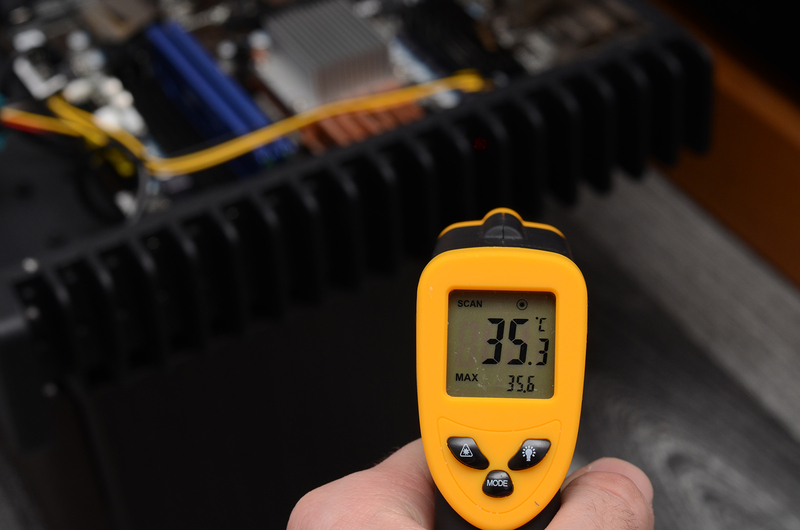
CPU heatsink:

Motherboard radiator:
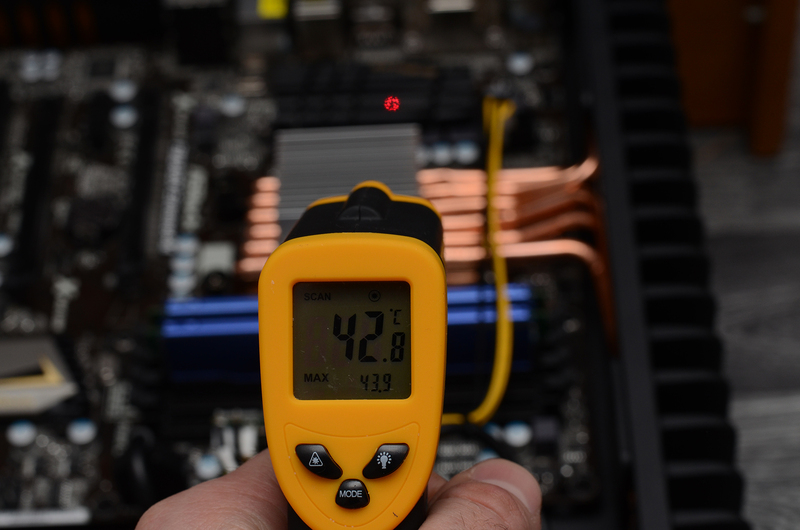
RAM:
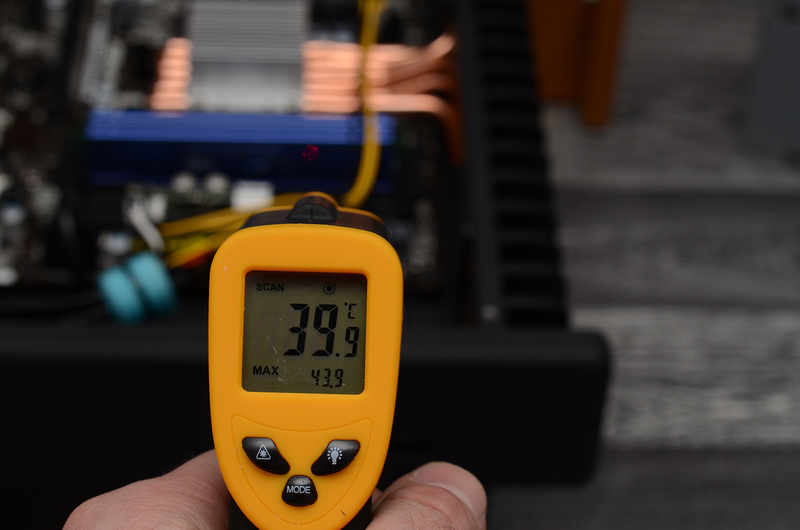

CPU heatsink:

Motherboard radiator:

RAM:

Blu-ray playback. CPU temperature = 55˚ C; motherboard = 38 ˚ C
Temperature on the components
Body:

CPU heatsink:
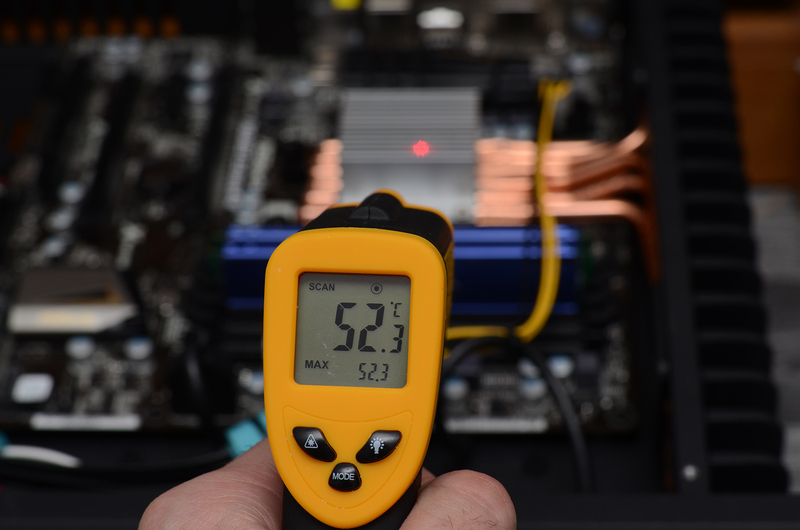
Motherboard radiator:
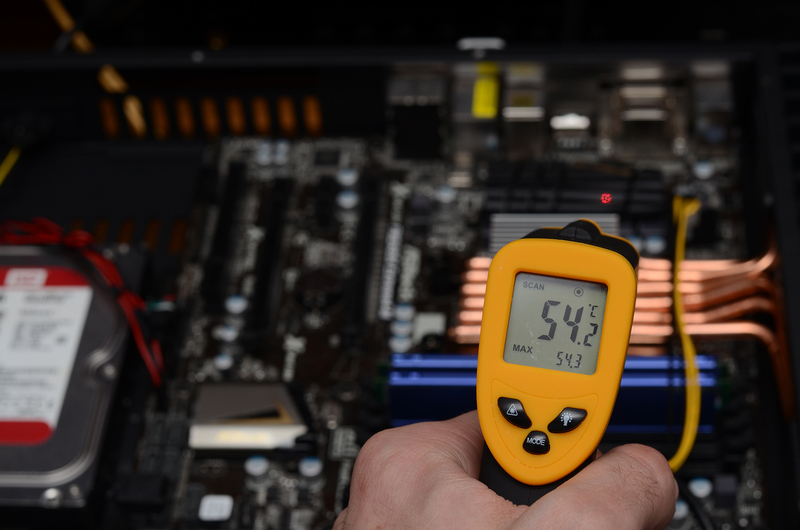
RAM:
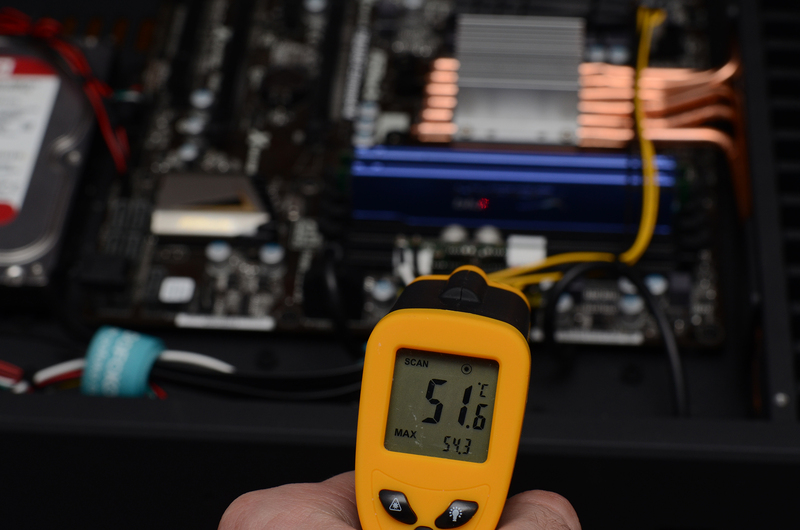
HDD:
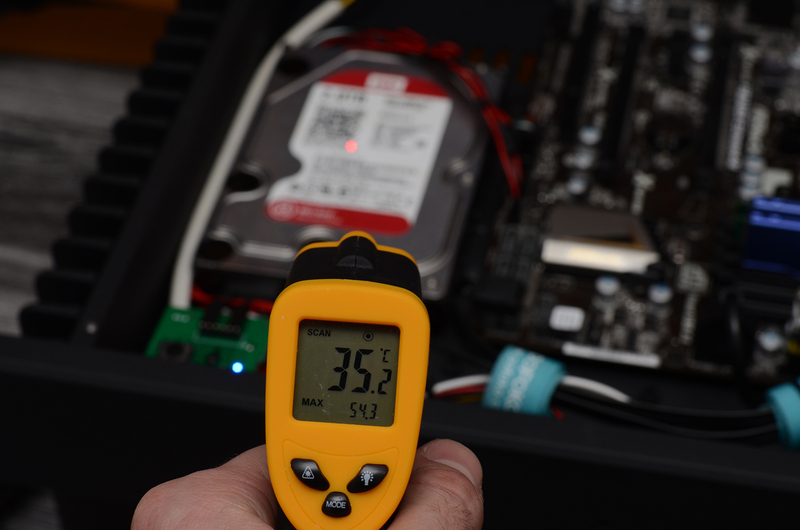

CPU heatsink:

Motherboard radiator:

RAM:

HDD:

Media shell idle mode (XBMC enabled) CPU temperature = 60˚ C; motherboard = 37 ˚ C
Temperature on the components
Body:

CPU heatsink:
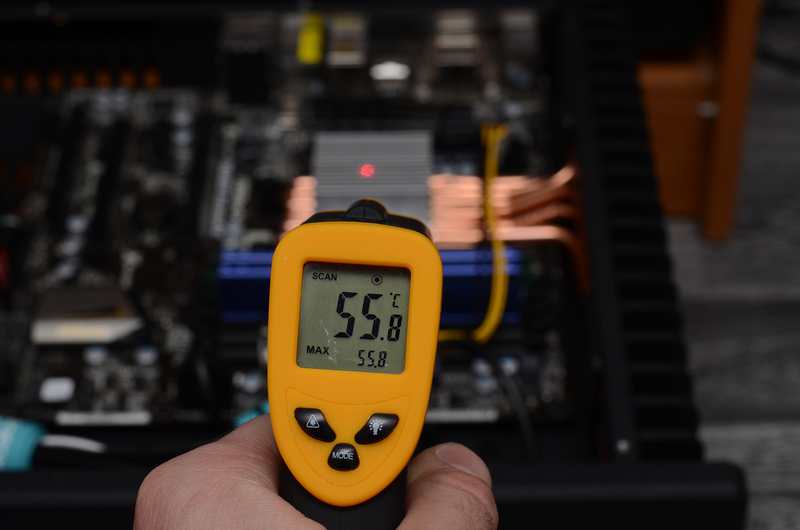
Motherboard radiator:
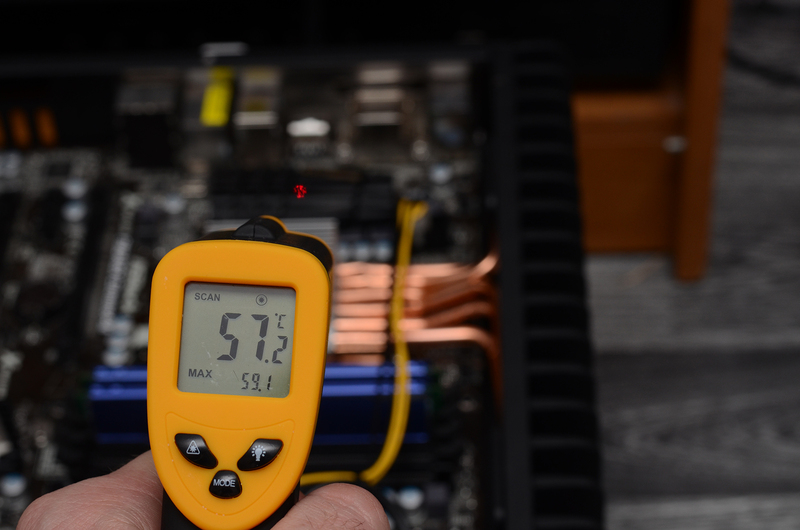
RAM:
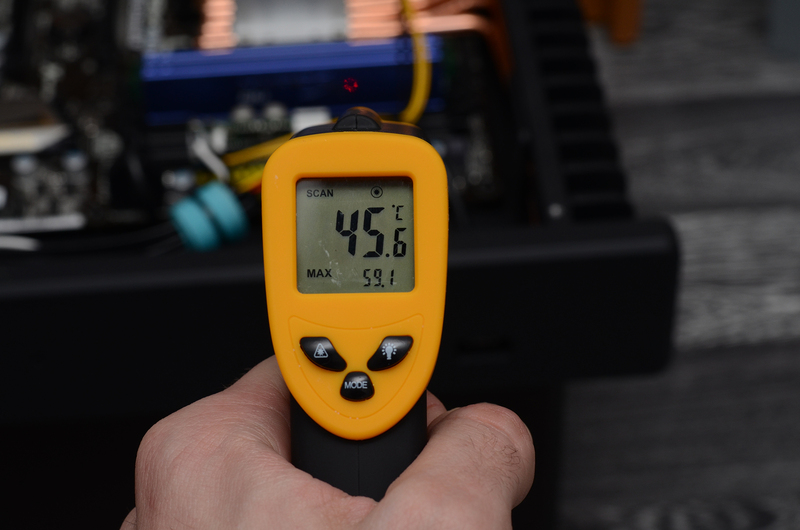

CPU heatsink:

Motherboard radiator:

RAM:

Blu-Ray 3D playback with TMT 6. CPU temperature = 63˚ C; motherboard = 35 ˚ C
Temperature on the components
Body:
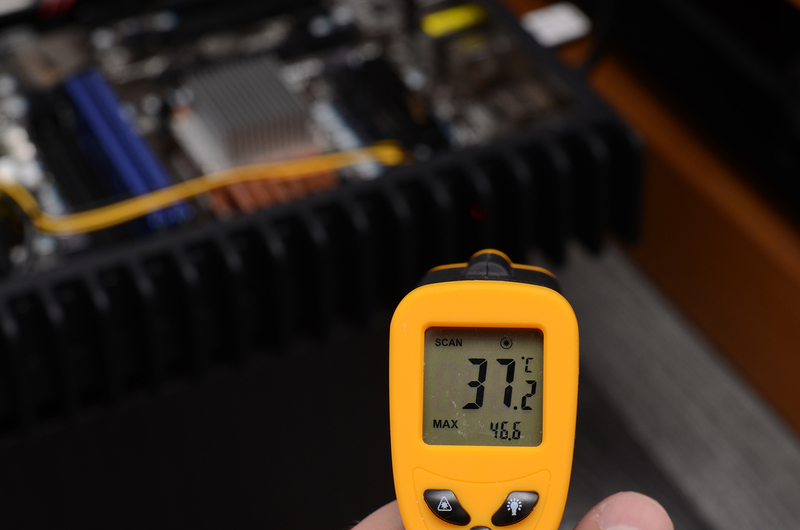
CPU heatsink:
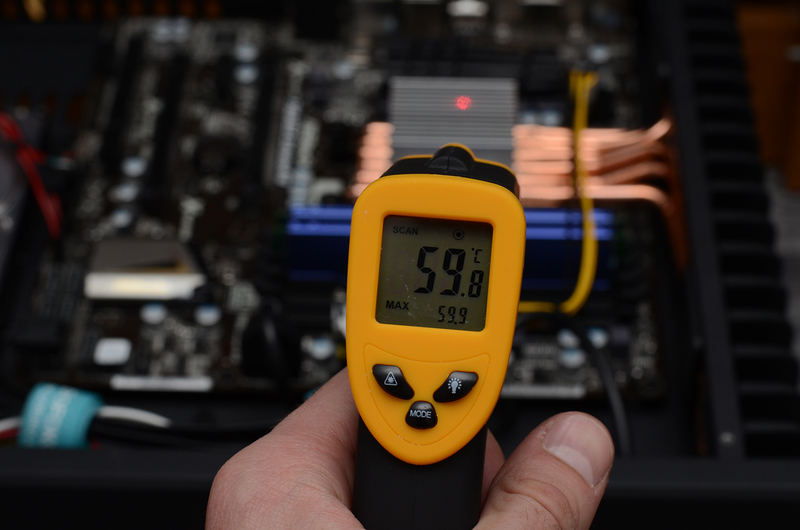
Motherboard radiator:
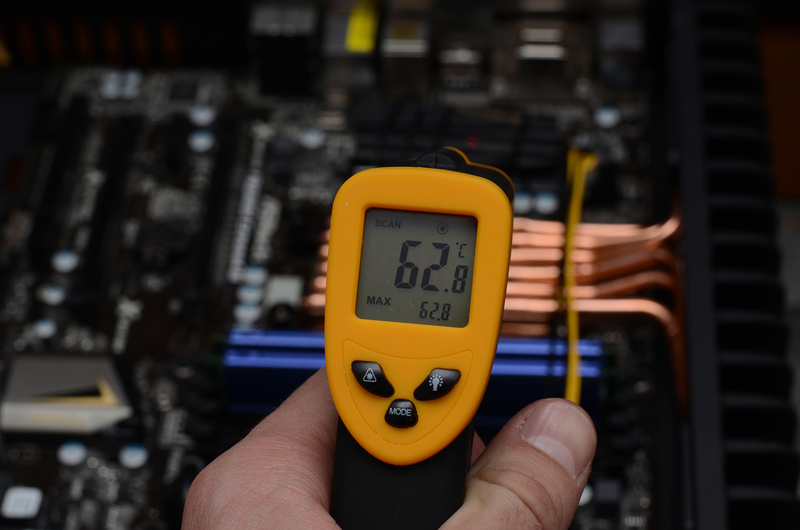
RAM:


CPU heatsink:

Motherboard radiator:

RAM:

Maximum load mode. CPU temperature = 95˚ C; motherboard = 39˚ C
Temperature on the components
Here it is worth making an explanation. I do not know what it is connected with, but when entering the BIOS, the processor load becomes maximum: in a matter of minutes, both the CPU and the radiator on the motherboard heat up. I take it for the maximum load mode.
Body:
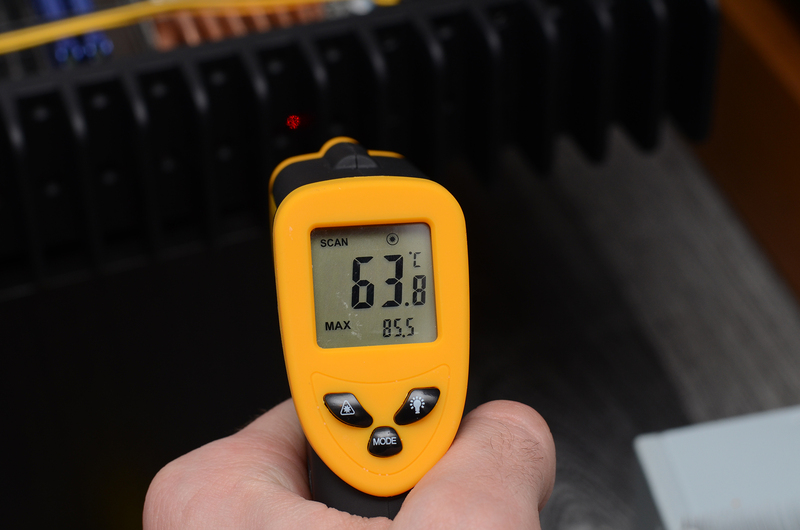
CPU heatsink:
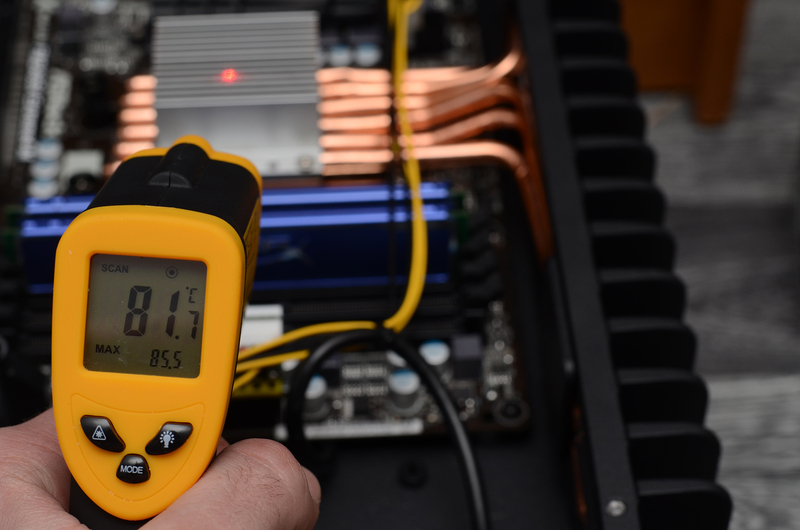
Motherboard radiator:
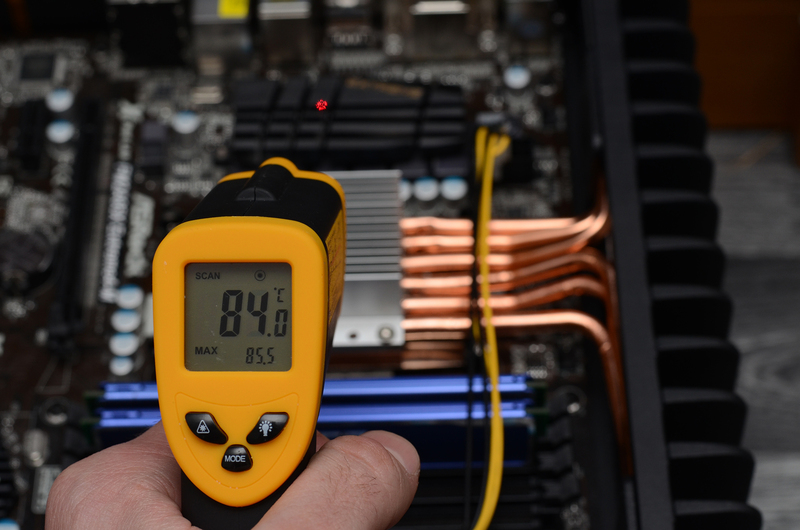
RAM:
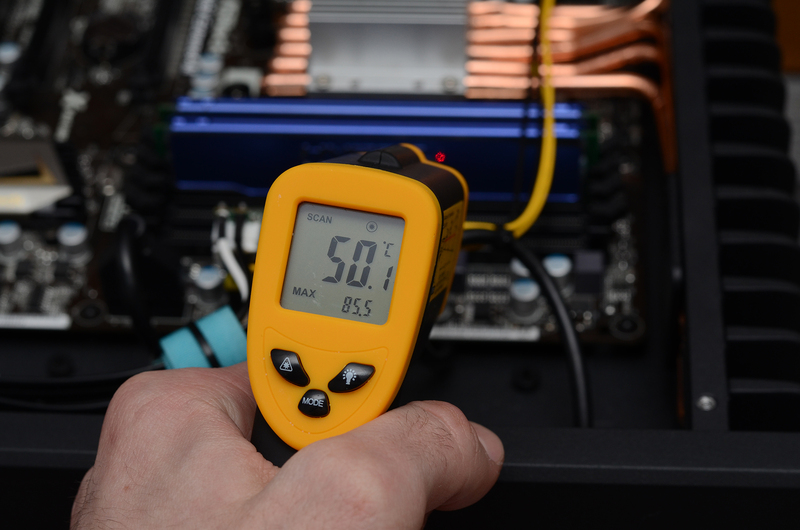
Body:

CPU heatsink:

Motherboard radiator:

RAM:

Some conclusions
1) The purchase was not made in vain, I was satisfied with the body. Very high quality;2) I consider the temperature conditions normal. He does not ask to eat, the heat dissipated is the same as in the case of active and passive cooling. Enclosure suitable for use 24/7;
3) I think the price is more than acceptable - at the level of a decent case with active cooling;
4) Remote control receiver is a disappointment.
Unresolved issues and errors
I have a few questions, the answers to which I have not yet found:1) Why does the idle temperature differ so much with the idle media temperature (=> why the load is cast)? A difference of 20˚ C is significant. But that is not all. The temperature in Blu-Ray playback mode is lower than in media shell idle mode, which means that in idle mode, the shell itself loads the GPU (since the CPU load is within 0–3%). There is a suspicion that the Aeon Nox skin can do this, I will try to change it to the standard one);
2) Why is the BIOS so heavy on the processor at least?
3) I nakosyachil with thermopaste - poured it too much. There are plans to replace it with another one and apply it with a thin layer, as well as apply thermal grease to the pipe receivers in the housing.
Source: https://habr.com/ru/post/175033/
All Articles